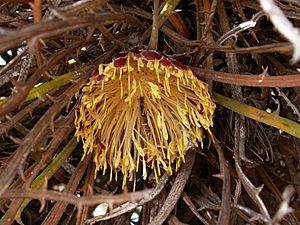Wongan dryandra facts for kids
Quick facts for kids Wongan dryandra |
|
|---|---|
 |
|
| Conservation status | |
| Scientific classification | |
| Genus: |
Banksia
|
| Species: |
comosa
|
| Synonyms | |
|
|
The Banksia comosa, also known as Wongan dryandra, is a type of shrub found only in Western Australia. It has long, thin leaves with sharp, spaced-out teeth. Its flowers are yellow and grow in groups, and its fruits are smooth.
Contents
What Does the Wongan Dryandra Look Like?
The Wongan dryandra is a thick, bushy shrub. It usually grows up to 3 m (9.8 ft) tall. Unlike some plants, it does not have a special underground stem called a lignotuber that helps it regrow after fires.
Leaves of the Wongan Dryandra
Its leaves are long and often a bit bent. They can be 10–35 cm (3.9–13.8 in) long and 4–8 mm (0.16–0.31 in) wide. Each leaf has a short stem, or petiole, up to 20 mm (0.79 in) long. On each side of the leaf, there are about eight to fifteen sharp, narrow, triangle-shaped teeth.
Flowers and Fruits
The flowers of the Wongan dryandra grow in groups, with 110 to 150 flowers in each group. Dark reddish-brown leaves, called involucral bracts, surround these flower heads. These bracts can be up to 35 mm (1.4 in) long.
Each flower has yellow parts called a perianth, which are 25–27 mm (0.98–1.06 in) long. It also has a special part for reproduction, called a pistil, which is 27–29 mm (1.1–1.1 in) long. The Wongan dryandra blooms from August to October. After flowering, it produces smooth, egg-shaped fruits called follicles, which are 11–15 mm (0.43–0.59 in) long.
Where Does the Wongan Dryandra Grow?
The Wongan dryandra lives in a type of shrubland called kwongan. It is only found in a specific area known as Wongan Hills in Western Australia.
How Is the Wongan Dryandra Protected?
The Government of Western Australia's Department of Parks and Wildlife lists this banksia as "Priority Four". This means it is rare or almost threatened, so it needs special care to protect it.


